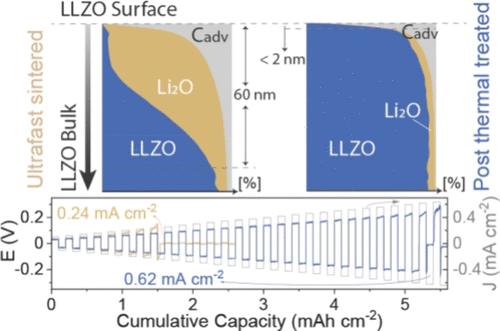当前位置:
X-MOL 学术
›
Chem. Mater.
›
论文详情
Our official English website, www.x-mol.net, welcomes your
feedback! (Note: you will need to create a separate account there.)
Unveiling Surface Chemistry of Ultrafast-Sintered LLZO Solid-State Electrolytes for High-Performance Li-Garnet Solid-State Batteries
Chemistry of Materials ( IF 7.2 ) Pub Date : 2024-11-05 , DOI: 10.1021/acs.chemmater.4c02351 Huanyu Zhang, Matthias Klimpel, Krzysztof Wieczerzak, Romain Dubey, Faruk Okur, Johann Michler, Lars P.H. Jeurgens, Dmitry Chernyshov, Wouter van Beek, Kostiantyn V. Kravchyk, Maksym V. Kovalenko
Chemistry of Materials ( IF 7.2 ) Pub Date : 2024-11-05 , DOI: 10.1021/acs.chemmater.4c02351 Huanyu Zhang, Matthias Klimpel, Krzysztof Wieczerzak, Romain Dubey, Faruk Okur, Johann Michler, Lars P.H. Jeurgens, Dmitry Chernyshov, Wouter van Beek, Kostiantyn V. Kravchyk, Maksym V. Kovalenko

|
Ultrafast (UF) sintering emerges as a game-changing sintering methodology for fabricating Li7La3Zr2O12 (LLZO) solid-state electrolytes, representing a pivotal stride toward the advancement and prospective commercialization of Li-garnet solid-state batteries. Despite its widespread use in the fabrication of LLZO ceramics, the chemical composition of the UF-sintered LLZO surface remains largely unexplored. This study presents an in-depth analysis of the surface chemistry of UF-sintered LLZO using comprehensive techniques, including depth-profiling X-ray photoelectron spectroscopy (XPS) and focused-ion-beam time-of-flight secondary ion mass spectroscopy (FIB-TOF-SIMS). Our investigation uncovers a striking difference between the surface of UF-sintered and conventionally sintered LLZO, revealing predominant surface contamination by Li2O up to ca. 40 nm depth in the case of UF processing. Comparative synchrotron X-ray diffraction data during UF and conventional sintering elucidate the origin of surface contamination. We propose a viable solution to this issue through an additional heat treatment (HT) step at 900 °C after UF sintering, as corroborated by XPS and FIB-TOF-SIMS measurements. Furthermore, we present a comparative assessment of the electrochemical performance of Li/LLZO/Li symmetric cells based on UF-sintered LLZO pellets, both with and without the post-HT step, underscoring the pivotal role of an uncontaminated LLZO surface.
中文翻译:

揭开用于高性能锂石榴石固态电池的超快烧结 LLZO 固态电解质的表面化学
超快 (UF) 烧结成为制造 Li7La3Zr2O12 (LLZO) 固态电解质的一种改变游戏规则的烧结方法,代表了锂石榴石固态电池的进步和潜在商业化的关键一步。尽管 LLZO 陶瓷被广泛用于制造 LLZO 陶瓷,但 UF 烧结 LLZO 表面的化学成分在很大程度上仍未得到探索。本研究使用综合技术对超滤烧结 LLZO 的表面化学进行了深入分析,包括深度剖析 X 射线光电子能谱 (XPS) 和聚焦离子束飞行时间二次离子质谱 (FIB-TOF-SIMS)。我们的调查揭示了超滤烧结和常规烧结 LLZO 表面之间的显着差异,揭示了在超滤加工中,Li2O 的主要表面污染深度约为 40 nm。超滤和常规烧结过程中的同步加速器 X 射线衍射数据比较阐明了表面污染的来源。我们通过在 UF 烧结后在 900 °C 下进行额外的热处理 (HT) 步骤来解决这个问题,XPS 和 FIB-TOF-SIMS 测量证实了这一点。此外,我们对基于 UF 烧结 LLZO 颗粒的 Li/LLZO/Li 对称电池的电化学性能进行了比较评估,无论有没有 HT 后步骤,强调了未受污染的 LLZO 表面的关键作用。
更新日期:2024-11-05
中文翻译:

揭开用于高性能锂石榴石固态电池的超快烧结 LLZO 固态电解质的表面化学
超快 (UF) 烧结成为制造 Li7La3Zr2O12 (LLZO) 固态电解质的一种改变游戏规则的烧结方法,代表了锂石榴石固态电池的进步和潜在商业化的关键一步。尽管 LLZO 陶瓷被广泛用于制造 LLZO 陶瓷,但 UF 烧结 LLZO 表面的化学成分在很大程度上仍未得到探索。本研究使用综合技术对超滤烧结 LLZO 的表面化学进行了深入分析,包括深度剖析 X 射线光电子能谱 (XPS) 和聚焦离子束飞行时间二次离子质谱 (FIB-TOF-SIMS)。我们的调查揭示了超滤烧结和常规烧结 LLZO 表面之间的显着差异,揭示了在超滤加工中,Li2O 的主要表面污染深度约为 40 nm。超滤和常规烧结过程中的同步加速器 X 射线衍射数据比较阐明了表面污染的来源。我们通过在 UF 烧结后在 900 °C 下进行额外的热处理 (HT) 步骤来解决这个问题,XPS 和 FIB-TOF-SIMS 测量证实了这一点。此外,我们对基于 UF 烧结 LLZO 颗粒的 Li/LLZO/Li 对称电池的电化学性能进行了比较评估,无论有没有 HT 后步骤,强调了未受污染的 LLZO 表面的关键作用。


















































 京公网安备 11010802027423号
京公网安备 11010802027423号